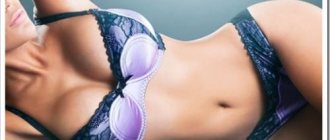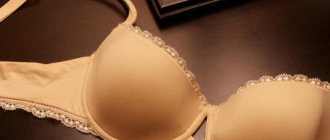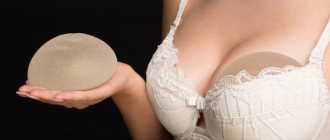A woman's breasts are one of the most important arguments in finding a sexual partner. Probably not a man who would refuse to admire a gorgeous bust, or even better, touch it. When a girl with size 4-5 breasts walks by, men's necks curl. What leads them? The instinct to reproduce? An image circulated by the media? Let's try to understand this issue.
A little history
The very existence of breasts raised many questions among men. In 1300, the physician Henri de Mondeville wrote to the king about three reasons for placing the breast in this place:
- This is how you can see her best.
- Breasts warm the heart.
- Breast weight helps women maintain abdominal strength.
By 1840, knowledge about breasts was still very limited. Thus, the doctor Asti Cooper said that breasts help lower-class women withstand very strong blows in fights (beatings due to drunkenness).
Let's figure out what is now known about breasts and nipples and how to properly treat them.
“I’m a guy, and I grew female breasts.” Living with gynecomastia: personal experience
Gynecomastia can develop due to medications, particularly antidepressants and nutritional supplements that are popular among athletes. Both stress and an unhealthy lifestyle can lead to illness at any age.
“Female breasts” often appear in boys during the period of hormonal changes: between the ages of 12 and 15 years, when male hormones, androgens, and female hormones, estrogens, “compete” with each other. Sometimes the “feminine principle” takes over, and then the boys get puffy nipples, and sometimes whole breasts.
Gynecomastia becomes the cause of psychological complexes. Such boys are bullied, they withdraw into themselves and live, hiding their defect and being ashamed of it.
Lesha is 28 years old, and he agreed to tell us his story:
“I first noticed that something was wrong with my body when I was 14. I moved to the ninth grade: over the summer I stretched out and lost weight, my figure suddenly turned from a child’s to a teenager’s. A typical “mantis”.
It was a physical education lesson: I forgot my sports uniform and trained in a tight-fitting sweater. Looking at myself in profile in the mirror, I noticed that my nipples stuck out a little in relation to the general line of my torso. I didn’t attach much importance to this and continued training, but after examining myself again, I realized that I was uncomfortable. He returned to the locker room and put on his vest. The issue was closed. It was autumn - time for turtlenecks and sweaters.
The nipples stuck out more and more, the changes could not be hidden.
Strictly speaking, I never had “breasts,” just flat, dry muscles and completely disproportionate nipples.
It was then that I first turned to my parents for advice. Realizing that puberty is a bizarre process, my family advised me to wait. In the end, the body will change its mind to rebel, and my breasts will become the same. And I waited. But I expected something completely different.
In the winter of that year, I went to a Christmas party at the home of my English tutors. They gathered almost all their students - children and teenagers - for the holiday. That evening I put on a thin, khaki-colored sweater—the perfect camouflage for my nipples, it seemed to me. And now, slow dance. I invited a classmate. The music started playing. The light fell almost vertically, turning the nipples into two large protruding “figs”.
The girl was much shorter than me and for the entire three minutes of the dance she looked at my chest almost point blank, biting her cheeks so as not to laugh.
I was counting down the seconds until the end of the song so I could quickly put on my down jacket and finally get home.
After that, a period of baggy clothes entered my life, which helped me a lot. Nipples were easy to hide with bulky T-shirts, and their complex patterns visually smoothed out the contours of the body. I have collected a whole collection of these for all occasions. Sweaters have been replaced by sweatshirts and thick hoodies. I was almost always protected from the sidelong glances and snickers of my classmates. The exceptions were situations when stripping to the waist was necessary: visits to the doctor, brief moments of nudity in the locker room. But here I found a solution.
I found that if I squeezed my nipples hard, they would shrink a lot in size for about a minute. I waited for the right moment, brought my hands together in a closed position and made two pinches - during these 60 seconds I hastily changed my clothes.
A year later, I was surprised to learn that my best friend was facing the same problem. Knowing that you were not alone made my life easier: now I could share the problem and joke about it.
We found out on the Internet that Pharaoh Akhenaten had gynecomastia. “What do you have, puffy nipples?” - “Ha, nipples... This is Pharaoh’s disease!” I won’t say that it was easier for my friend, but he was able to accept his body with less loss. He was taller, bigger, and the nipples seemed to complement his fullness. Well, thick and thick. In my case, it seemed to me that gynecomastia made me a caricature of a person.
I grew up and matured, and my first romantic interests appeared in my life. Needless to say, I didn’t imagine any close connection with the girl. Should I take off my T-shirt in front of her so she can see “this”? No. Never.
All the time I did not stop searching for the perfect disguise of my flaw. Once I saw special covers in a women's accessories store, designed just so that girls could hide their nipples under clothes. Here it is, the solution! Ripping open the packaging, I took out the thin flower-shaped patches, which were not nearly as sticky as I expected and were obviously only suitable for wearing under a bra. I was terribly disappointed.
Soon I finally found a thing that helped me hide my gynecomastia for almost the next three years. It turned out to be my mother's elastic T-shirt.
It did not fit, but rather squeezed the torso, and besides, it was very light and thin - almost like a second skin. Now I could calmly and safely put on T-shirts, shirts and polos. The only negative was that in the summer the body was terribly hot from synthetics, and the sultry day felt like midday in the Sahara. But my secret was under lock and key.
As my parents advised, I waited four years for the gynecomastia to finally go away, but it still didn’t go away. Once I asked my friend: “Listen, do you really want to live your whole life like this - hiding, being embarrassed?” He replied: “You know, I’ve already resigned myself. It’s not that scary.” I experienced completely different feelings. Then I decided that I was mortally tired of my illness: it was no longer possible to hide it - which means I needed to get rid of it.
As it turned out, this is not so easy to do.
Gynecomastia, as a rule, is extremely uncomfortable, but not dangerous - which means there are no medical indications for its removal.
That is, from the point of view of state medicine, getting rid of gynecomastia was simply my “wish”. The first doctor I turned to with my problem was a regional urologist. He conducted a full examination, studied blood tests and, not seeing any disruption in hormone levels, advised me to fight my nipples by building muscle: “You take a barbell - and every day, every day. When your breasts are like wheels, you’ll forget about your nipples.” I was at a loss. Given my frailty, I had little idea of the prospect of many years of bodybuilding, knowing that gynecomastia would not go away, but would simply become less noticeable.
The second doctor I came to for advice was a young endocrinologist. His solution was to undergo hormone therapy. The first thing I had to do was give myself an injection of a special hormone called human chorionic gonadotropin, so that the body's reaction would show what doses of testosterone my body needed. The injection was given, hormones were prescribed, but then I became scared.
The doctor mentioned that therapy sometimes has the opposite effect - the mammary glands increase in size. As I learned later, the risk of developing cancer also increases.
I also refused this treatment.
I was almost in despair when I came across the website of a surgeon who would later change my life. As it turned out, gynecomastia was his specialty, and the “before” and “after” photographs of patients gave me hope.
Arriving at the appointment, I learned that there are different gynecomastia: false - that is, those that develop against the background of obesity; and true ones - those that arise against the background of hormonal imbalance. Since mine was true, none of the types of conservative treatment (ointments, tablets) suited me. This means there is only one way out - surgical removal of the glands, that is, a mastectomy. The cost of the procedure turned out to be rather large, but for 2009 it was, as they say, exportable - about twenty thousand rubles.
The operation took place in a small private clinic.
I was taken to the operating room, placed on a couch and given local anesthesia to numb the pectoral muscles. All this time, of course, I was conscious. The doctor made incisions along the contour of the nipple areolas, and then, one by one, sharply tore out sections of excess tissue.
The key moment was the formation of a “new” breast: the surgeon evenly distributed the fat layer: “You need to make a pillow so that the nipples do not fall in, but seem to lie on their natural surface,” the doctor explained. The doctor placed stitches and wrapped the torso tightly with a wide elastic bandage to fix the shape of the breasts. They showed me what my gynecomastia looked like: bright yellow fibrous “licks” the size of a tennis ball. I had an unpleasant and worrying week ahead of me: it was hard to breathe, and it was almost impossible to sleep and walk.
I will never forget the day my stitches were removed. The doctor cut off the black threads, shook my hand and wished me good luck. This moment divided my life into “before” and “after.” I left the clinic building wearing only a T-shirt. I could barely contain my glee as I walked slowly along the boulevard. Peering into the faces of passers-by, I seriously expected some kind of reaction: “Look, there are no nipples at all!” But no one paid attention to me. There was nothing to see - just an 18-year-old guy in a black T-shirt.
After I started studying at the university, my friend and I went our separate ways. But a few years later we finally met. I told him that I had my gynecomastia removed and I felt happy. But he never changed anything.”
Commented by Ruslan Yurievich Petrovich - andrologist, plastic surgeon, author of the website www.g-mastia.ru
“Teenage gynecomastia is usually associated with a lack of nutritional culture. It's all because of junk food and fast carbohydrates. As a result, boys reach puberty with excess weight, usually on the lower back, sides and abdomen. Because of this, testosterone, which should have been used to build a male body, is partially converted into the female hormone estradiol in excess fat tissue. This leads to the growth of mammary glands in a teenager.
The paradox is that the rudimentary mammary glands inherent in us “do not know” which body they are in - female or male - and will behave as hormones tell them.
In some cases, small teenage gynecomastia may actually go away on its own. Usually - within six months after occurrence or up to 15 years. If this does not happen, treatment can only be surgical.
The main problem of teenage gynecomastia is rejection or misunderstanding on the part of parents, as well as the unprofessional attitude of doctors. In my practice, there was a case when a district endocrinologist refused to treat a teenager with the words “let this be your personal trick.”
In most cases, doctors suggest waiting until 18 years, suggesting that gynecomastia can go away on its own. But the grown gland cannot simply disappear and dissolve. The body doesn't work that way. I know many examples when, over many years of waiting, teenagers with female breasts acquired severe psychological complexes, deprived themselves of the opportunity to play sports and suffered from poor posture. The lack of support from parents and their fear of surgery only delays the moment of getting rid of gynecomastia and interferes with a normal life.”
Facts about breasts and nipples
Nipples may not always be the center of pleasure
Dr. Debbie Herbenick, author of The Coregasm Workout, says the nipples may not be the most sensitive spot, even on the chest. For example, some people's upper and sides of the chest may be more sensitive, or even the most sensitive on the body.
Dr. Lowe has made a separate video on how to properly touch your breasts. Take a look to understand the scale of missed opportunities.
Orgasm from nipple stimulation is possible
Researchers Sex on the brain: What turns women on, mapped out. from Rutgers University used MRI to show that nipple stimulation activates the same nervous system as genital and clitoral stimulation. True, nothing compares to the effect on the clitoris. The nervous system is the same, but the force of influence is different.
newscientist.com
So, theoretically, an orgasm from nipple stimulation is possible, but it is still rare.
Evolution has taken a shine to male nipples
Women need nipples to remove milk and feed their offspring. But the purpose of male nipples has long been an object of scientific interest. The fact is that nipples are formed in the womb before the genitals, since men and women are created using the same genetic code.
At 6–7 weeks of pregnancy, a gene on the Y chromosome induces changes that lead to the development of the testes, the organs that produce and store sperm. After about 9 weeks of pregnancy, the testes begin to produce testosterone, changing the genetic activity of cells in the genitals and brain. But by this time the nipples are already formed. Therefore, they remain a rudimentary formation.
Scientists believe that over time, nipples in men did not disappear because it was not important for evolution.
Nipples can come in different sizes, shapes and colors
Many women worry about the way their nipples look, but you shouldn't. Dark, upside down, big, small, brown, light - this is all normal. Here you can see all the variety of nipples in nature.
imgur.com
Areolas, the colored areas of skin around the nipples, are just as diverse. They can be darker or lighter, very small or large. And areola hair is normal. Throughout life, the amount of hair on them changes. And during pregnancy, nipples and areolas may become larger and darker.
The small bumps on the areola are called areolar glands, or Montgomery glands. They are named after the scientist William Montgomery, who first described them in 1837. They are also sometimes called “gummy bears.” The fact that they exist is normal, but their purpose is unknown.
The head of breast surgery at the medical school, Elisa Port, says the areolar glands can secrete small amounts of fluid, but they have no special function. Another school of thought is that because of the texture of the glands, babies may use them to find their way to the nipple. But this is just a guess.
Three nipples are not that uncommon
Harry Styles and Mark Wahlberg live with three nipples. Statistics confirm that this anomaly, also called a supernatural nipple, is more common in men. Rates range from 0.22% to 5.6%.
In theory, extra nipples can appear along the milk lines, which start in the armpits on each side and end in the groin.
Usually this is still one extra nipple. But there is a man Seven nipples in a male: World's second case report. with seven nipples and a man with a nipple on the foot Case report: ectopic nipple on the sole of the foot, an unexplained anomaly. .
During menstruation, breasts become dense and nipples become hypersensitive.
Dr. Sherry Ros says this is due to an increase in the hormones estrogen and progesterone 1-2 weeks before your period.
If you are someone who suffers from PMS, your breasts will become firmer, heavier, and more sensitive during your period. The nipples may even be painful when touched by clothing. It's best to avoid caffeine and tobacco during your period, as they can increase these side effects.
Implants will not interfere with breastfeeding
The implants are inserted behind the breast or behind a muscle, so they will not affect breastfeeding.
But the pleasant sensations from touching will decrease - both in the nipples and in the chest. Even complete loss of sensitivity is possible. Research on Nipple-Areola Complex Sensitivity after Primary Breast Augmentation: A Comparison of Periareolar and Inframammary Incision Approaches. They also showed a connection between the size of the implant and sensations: the larger it is, the lower the sensitivity.
Breast reduction can affect feeding, and it is almost impossible to predict - much depends on the operation. If the nipple is displaced during this procedure, the milk ducts will be cut out and breastfeeding will be impossible. However, more and more operations are being done so as not to damage the nerves under the nipple and ensure blood supply.
It is better to warn doctors in advance if you plan to breastfeed in the future. Ask if the operation can be done in a way that preserves the milk ducts.
Breastfeeding is harder than it seems
There is a myth about the naturalness and ease of breastfeeding. But in reality everything turns out differently. If you're having problems, don't be afraid to ask your doctors for help or see a lactation specialist.
In addition, breastfeeding has consequences in the form of cracked and bleeding nipples. It's not harmful to your health, but it can be incredibly painful, so you won't want to breastfeed anymore.
During this period, your nipples need to be looked after and moisturized. Consult your doctor and find out which ointment is best for you to use. If the ointment does not help, contact a specialist again. You may have a yeast infection. It is easy to cure, you just need to notice it in time.
Inverted nipples can also interfere with breastfeeding - it will be difficult for the baby to latch on to them. In this case, silicone nipple shields will help. They apply pressure to the areolas and nipples and break the small adhesions that hold the nipple in place.
Word of science
Many have heard the version that large breasts, like wide hips, are an indicator of high survival rate of offspring from this woman. Wide hips will make it easy to give birth, and large breasts will allow you to feed your baby. Although, breast size does not matter much here. During the feeding period, the iron begins to work at full capacity, and the breasts increase slightly from the influx of blood and milk.
And male genetics is aimed at scattering as much of his seed as possible, then the probability of having offspring will be maximum. In this case, whether a woman has large or small breasts does not matter, he will no longer care about this offspring, it is important for him to fertilize as many females as possible.
Humans are the only species whose males are so obsessed with the sight of female breasts. It is interesting that in women, the breasts increase not only during the period of bearing and feeding their young, as in all mammals, but with the onset of puberty and remain so throughout their lives. Research says that men are attracted to sizes slightly larger than average, so females try to attract a potential partner.
Many scientists adhere to Freud's theory, according to which every man, to one degree or another, is a carrier of the “Oedipus complex”; he experiences love for his mother and jealousy for his father.
He is trying to take his father's place, and there is a slight hint of sexuality in the son's love. In the future, on the contrary, he treats every woman a little like a mother.
What is your first impression of communicating with your mother? Kind eyes, gentle hands and warm breasts full of milk. Receiving food every day, the child looks into the mother’s face and remembers her. The woman bends over the baby, holds out her breast to him, and takes care of him. And the first pleasant memories are associated with this action.
Therefore, scientists believe that breasts have not so much a sexual context, but are associated with calmness and care. It is not without reason that many men like to lay their heads on the chest of the woman they love during difficult periods of their lives. To some extent, they all remain mama's boys, in need of care and a sense of security.
Some psychologists even associate the use of the traditional missionary position, which is unique to humans, as a consequence of the bond between mother and child. The man stimulates the female nipples in the process, thereby causing the release of pleasure hormones not only in the woman, but also in himself.
He triggers mechanisms laid down in infancy, when contact with a woman’s breast brought pleasure. The same applies to direct eye contact, which is inevitable in the missionary position; it promotes greater trust between partners and increases the pleasure of both.
On the other hand, breasts have long been a hidden object. It seems to be there, but it is not shown. This situation arouses burning interest and a desire to touch.
It’s not for nothing that smart women don’t put their breasts on full display; they prefer to slightly open their treasures, hinting at their presence, but not showing them completely. The rest is completed by men's imagination.











